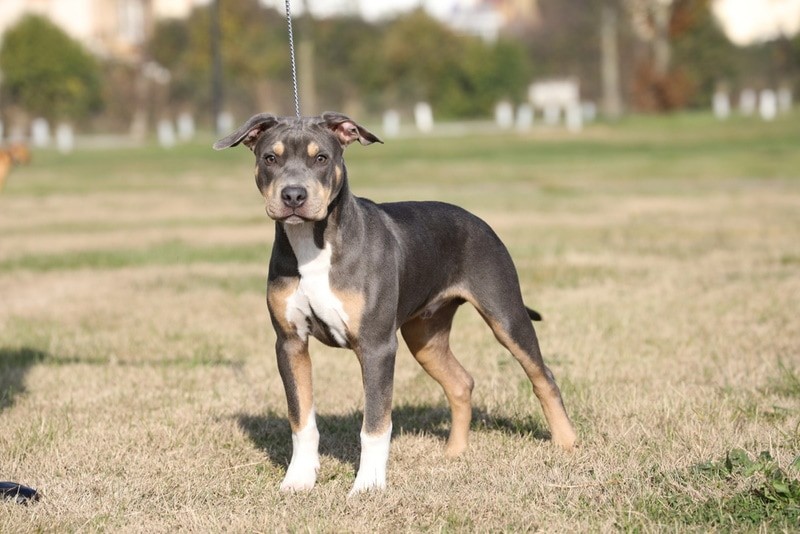
The American Pitbull Tri-Color represents one of the most distinctive and sought-after variations within the breed, characterized by its unique three-color coat pattern typically featuring combinations of black, white, and tan. This coloration, resulting from specific recessive genetic traits, has gained significant attention among enthusiasts and breeders alike. As of 2025, these dogs command premium prices ranging from $5,000 to $35,000 from reputable breeders, reflecting their rarity and desirability. Beyond their striking appearance, Tri-Color Pitbulls exhibit the breed's characteristic muscular build, friendly temperament, and adaptable nature, making them increasingly popular as family companions despite common misconceptions about the breed.
American Pitbull Tri Color
Genetics and Breeding Combinations
The tri-color pattern in Pitbulls emerges from specific genetic combinations. According to breeding experts, a blue nose and red nose Pitbull pairing can potentially produce tri-color offspring, though this requires both parents to carry the recessive genes for the tri-color trait. The pattern typically manifests as black on the back, white on the stomach and neck, with tan or brown accents on the muzzle, chest, and legs.
Market Value and Availability
Due to their relative rarity, tri-color Pitbulls command premium prices in the market. Adoption costs from shelters range from $50-$300, while reputable breeders charge between $1,000-$3,000. Some specialized breeders may charge up to $35,000 for puppies with exceptional pedigrees. Professional kennels like Clasepitbulls in New York focus on breeding various color combinations including tri-colors, offering health guarantees and UKC paperwork with their puppies. When considering purchase, it's important to factor in not just the initial cost but also ongoing expenses for care and maintenance.
Understanding Tri-Color Patterns in American Pitbulls
Pattern Distribution and Characteristics
While the previous section covered general tri-color genetics, this section focuses specifically on pattern distribution. According to Spirit Dog Training, the tri-color pattern typically features a black back, white underside (stomach and neck area), and tan/brown markings concentrated on the muzzle, chest, and legs. The pattern distribution remains fairly consistent across tri-color Pitbulls, though the intensity and exact placement of colors may vary. Spark Paws notes that these patterns are distinct from other multi-colored variations like brindle or merle.
Genetic Expression and Inheritance
The tri-color trait manifests through specific genetic mechanisms different from standard coat colors. The pattern requires both parents to carry and pass on the recessive genes responsible for the tri-color expression. This genetic complexity explains why tri-colors are less common than solid or bi-colored Pitbulls. The genes controlling the tri-color pattern are separate from those determining nose color (blue or red), which explains why tri-color puppies can emerge from various parental color combinations. The pattern's expression is also influenced by modifier genes that can affect the intensity and distribution of each color within the standard tri-color areas.
American Pitbull Tri Color
Health Considerations and Care
While previous sections covered pattern distribution and genetics, this section focuses on health aspects specific to tri-color Pitbulls. According to Spirit Dog Training, tri-color Pitbulls require special attention to their coat and skin health. They are particularly susceptible to demodex mange due to immunodeficiency, which can cause skin irritation and hair loss. Regular grooming and health monitoring are essential, with weekly brushing recommended to maintain coat health and distribute natural oils. They also have a higher susceptibility to parvovirus, making proper vaccination crucial.
Training and Socialization Requirements
Tri-color Pitbulls have unique training needs that differ from standard considerations covered in previous sections. Spirit Dog Training emphasizes that these dogs exhibit selective hearing, particularly in exciting situations with new people or dogs. Group training classes are highly recommended not just for obedience but for controlled socialization. Their high activity level and terrier-like enthusiasm require consistent training from an early age. While they're intelligent and trainable, their excitable nature means they shouldn't be trusted off-leash, especially around new stimuli. Success in training depends heavily on early socialization and consistent positive reinforcement techniques.
Conclusion
The research on tri-color American Pitbulls reveals several key findings about this distinctive coat pattern. The tri-color trait emerges from specific recessive genetic combinations, typically presenting as black on the back, white on the stomach/neck, and tan/brown accents on the muzzle, chest and legs. Due to the genetic complexity required, these dogs are relatively rare and command premium prices ranging from $1,000-$3,000 from reputable breeders, with some exceptional pedigrees reaching up to $35,000.
Beyond aesthetics, tri-color Pitbulls require special attention to health and training. They are more susceptible to certain conditions like demodex mange and parvovirus, necessitating vigilant healthcare and regular grooming. Their high energy levels and selective hearing tendencies mean early socialization and consistent positive reinforcement training are crucial for success. These findings highlight the importance of potential owners understanding both the financial commitment and care requirements before pursuing a tri-color Pitbull.